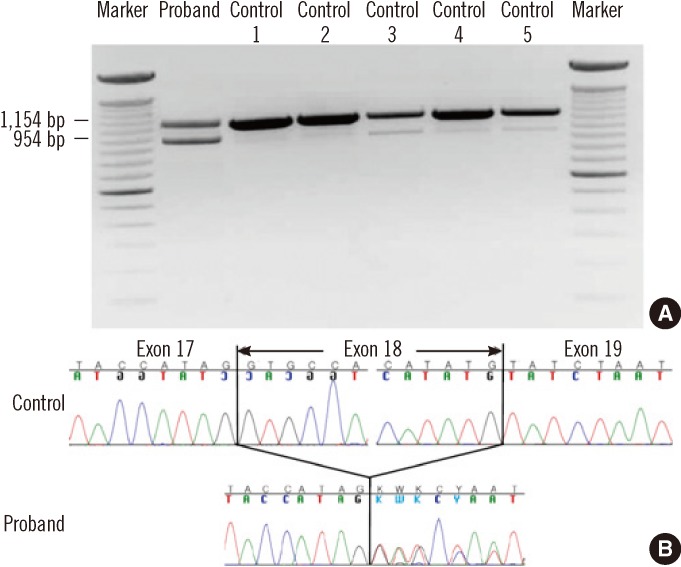Ann Lab Med.
2013 May;33(3):217-220. 10.3343/alm.2013.33.3.217.
Identification of ATM Mutations in Korean Siblings with Ataxia-Telangiectasia
- Affiliations
-
- 1Department of Laboratory Medicine and Genetics, Samsung Medical Center, Sungkyunkwan University School of Medicine, Seoul, Korea. changski@skku.edu
- 2Department of Neurology, Yonsei University College of Medicine, Seoul, Korea. phisland@chol.net
- KMID: 1781331
- DOI: http://doi.org/10.3343/alm.2013.33.3.217
Abstract
- Ataxia-telangiectasia (A-T) is a rare autosomal recessive neurodegenerative disorder. It is characterized by early-onset, progressive cerebellar ataxia, oculomotor apraxia, choreoathetosis, conjunctival telangiectasias, immunodeficiency, and an increased risk of malignancy. Although A-T is known to be the most common cause of progressive cerebellar ataxia in childhood, there have been no confirmed cases in Korea. We report the clinical and genetic findings of Korean siblings who presented with limb and truncal ataxia, oculomotor apraxia, choreoathetosis, and telangiectasias of the eyes. Sequence analysis of the ataxia-telangiectasia mutated (ATM) gene revealed a known missense mutation (c.8546G>C; p.Arg2849Pro) and a novel intronic variant of intron 17 (c.2639-19_2639-7del13). Reverse-transcription PCR and sequencing analysis revealed that the c.2639-19_2639-7del13 variant causes a splicing aberration that potentiates skipping exon 18. Because A-T is quite rare in Korea, the diagnosis of A-T in Korean patients can be delayed. We recommend that a diagnosis of A-T should be suspected in Korean patients exhibiting the clinical features of A-T.
MeSH Terms
-
Asian Continental Ancestry Group/*genetics
Ataxia Telangiectasia/diagnosis/*genetics
Ataxia Telangiectasia Mutated Proteins/*genetics
Child
Female
Heterozygote
Humans
Introns
Male
Mutation, Missense
Pedigree
Republic of Korea
Reverse Transcriptase Polymerase Chain Reaction
Sequence Analysis, DNA
Siblings
Ataxia Telangiectasia Mutated Proteins
Figure
Cited by 2 articles
-
Ataxia-Telangiectasia with Novel Splicing Mutations in the
ATM Gene
Heejeong Jeong, Hee Jae Huh, Jinyoung Youn, Ji Sun Kim, Jin Whan Cho, Chang-Seok Ki
Ann Lab Med. 2014;34(1):80-84. doi: 10.3343/alm.2014.34.1.80.The Etiologies of Chronic Progressive Cerebellar Ataxia in a Korean Population
Ji Sun Kim, Soonwook Kwon, Chang-Seok Ki, Jinyoung Youn, Jin Whan Cho
J Clin Neurol. 2018;14(3):374-380. doi: 10.3988/jcn.2018.14.3.374.
Reference
-
1. Biton S, Barzilai A, Shiloh Y. The neurological phenotype of ataxia-telangiectasia: solving a persistent puzzle. DNA Repair (Amst). 2008; 7:1028–1038. PMID: 18456574.
Article2. Beamish H, Khanna KK, Lavin MF. Ionizing radiation and cell cycle progression in ataxia telangiectasia. Radiat Res. 1994; 138(1 Suppl):S130–S133. PMID: 8146316.
Article3. Gatti RA, Berkel I, Boder E, Braedt G, Charmley P, Concannon P, et al. Localization of an ataxia-telangiectasia gene to chromosome 11q22-23. Nature. 1988; 336:577–580. PMID: 3200306.
Article4. Foray N, Marot D, Gabriel A, Randrianarison V, Carr AM, Perricaudet M, et al. A subset of ATM- and ATR-dependent phosphorylation events requires the BRCA1 protein. EMBO J. 2003; 22:2860–2871. PMID: 12773400.
Article5. Sandoval N, Platzer M, Rosenthal A, Dörk T, Bendix R, Skawran B, et al. Characterization of ATM gene mutations in 66 ataxia telangiectasia families. Hum Mol Genet. 1999; 8:69–79. PMID: 9887333.
Article6. Moreira MC, Barbot C, Tachi N, Kozuka N, Uchida E, Gibson T, et al. The gene mutated in ataxia-ocular apraxia 1 encodes the new HIT/Zn-finger protein aprataxin. Nat Genet. 2001; 29:189–193. PMID: 11586300.
Article7. Verhagen MM, Last JI, Hogervorst FB, Smeets DF, Roeleveld N, Verheijen F, et al. Presence of ATM protein and residual kinase activity correlates with the phenotype in ataxia-telangiectasia: a genotype-phenotype study. Hum Mutat. 2012; 33:561–571. PMID: 22213089.
Article8. Woods CG, Bundey SE, Taylor AM. Unusual features in the inheritance of ataxia telangiectasia. Hum Genet. 1990; 84:555–562. PMID: 2338342.
Article9. Campbell C, Mitui M, Eng L, Coutinho G, Thorstenson Y, Gatti RA. ATM mutations on distinct SNP and STR haplotypes in ataxia-telangiectasia patients of differing ethnicities reveal ancestral founder effects. Hum Mutat. 2003; 21:80–85. PMID: 12497634.
Article10. Telatar M, Teraoka S, Wang Z, Chun HH, Liang T, Castellvi-Bel S, et al. Ataxia-telangiectasia: identification and detection of founder-effect mutations in the ATM gene in ethnic populations. Am J Hum Genet. 1998; 62:86–97. PMID: 9443866.
Article11. Morio T, Takahashi N, Watanabe F, Honda F, Sato M, Takagi M, et al. Phenotypic variations between affected siblings with ataxia-telangiectasia: ataxia-telangiectasia in Japan. Int J Hematol. 2009; 90:455–462. PMID: 19705055.
Article12. Jiang H, Tang B, Xia K, Hu Z, Shen L, Tang J, et al. Mutation analysis of the ATM gene in two Chinese patients with ataxia telangiectasia. J Neurol Sci. 2006; 241:1–6. PMID: 16380133.
Article13. Kang DW, Ahn SS, Jeon BS. A case of ataxia telangiectasia. J Korean Neurol Assoc. 1997; 15:895–899.14. Song MH, Kim EJ, Sung TJ, Shin SH, Lee KH, Kim HD. A Case of progressive elevation of serum gamma-GTP level in ataxia-telangiectasia. J Korean Child Neurol Soc. 2006; 14:363–368.15. Saunders-Pullman RJ. Ataxia-telangiectasia: without ataxia or telangiectasia? Neurology. 2009; 73:414–415. PMID: 19605768.
Article
- Full Text Links
- Actions
-
Cited
- CITED
-
- Close
- Share
- Similar articles
-
- Ataxia-Telangiectasia Mutated Is Involved in Autolysosome Formation
- Functional Link between DNA Damage Responses and Transcriptional Regulation by ATM in Response to a Histone Deacetylase Inhibitor TSA
- A Case of Familial Telangiectasia of Face
- Ataxia-Telangiectasia with Novel Splicing Mutations in the ATM Gene
- Novel compound heterozygous mutations of ATM in ataxia-telangiectasia: A case report and calculated prevalence in the Republic of Korea



